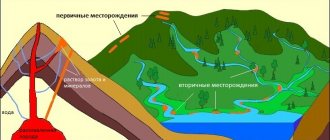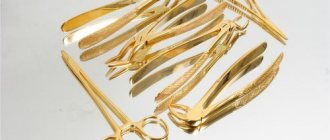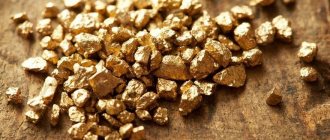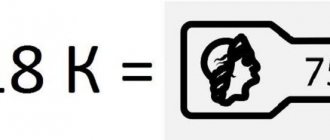In recent years, the media and the Internet have been filled with stories of deception of gullible villagers by various scammers. For example, a woman was selling a goat through a popular website, and her bank account with labor income suddenly went to zero after a call from the “buyers”. But it turns out that scams were practiced in our area long before the advent of the telegraph, telephone, and even Morse code. This is the story that happened back in the 19th century and is passed down from generation to generation by residents of the Krasnoshchekovsky district. Let’s immediately say a word of gratitude to Sergei Suvorov, a talented storyteller and collector of legends from the Foothills - that’s what he calls the area where his ancestors lived.
How it all started
Under Catherine II, nicknamed the Great, the treasury discovered expensive metal in Altai and began mining. Gold too, but mostly silver. Well, where the little gold starts, there the murder blossoms. Fierce. Merciless. Countless people of all kinds of unclean people appear (like they come out of the ground). Again, fraud, black mining, bribery and fraud begin, and after a while the police and gendarmerie begin to scratch. Searches, inquiries, trials, hard labor - the authorities are working.
State-owned goods have been known from time immemorial - they are fenced off by fear. That's something else! Have you seen what happens to a person if he attacks expensive metal? No?
Oooh, that’s not easy to describe. There was a man as a man, but he became the devil. It's like he's sick. The eyes are cunning, burning, running from side to side. The gait is slithering - fox-like, and sometimes even creeping, like that of a stray dog. He looks around all the way, as if someone is watching him.
People have specially nicknamed this condition of both man and life - gold fever (gold fever). In other words, a restless life.
How gold was mined in the past
The precious metal was mined in the gold-bearing rivers of Siberia: tributaries of the Ob, Yenisei and Tom. Until the mid-19th century, the method of obtaining raw materials was primitive: prospectors washed river sand. The lighter grains of sand were washed away, and the golden grains, being heavier, remained at the bottom. This is how large nuggets were found. The largest, weighing more than 36 kg, was found in 1842 M.N. Syutkin.
They tried to mechanize the process. For example, in 1875, the merchant Pakulev invented a machine that washed sand. At the same time, tests were carried out on the use of a mechanism that opened the rock. The first attempts were successful, but subsequent design imperfections prevented the use of the invention.
In eastern Siberia, since 1860, a huge machine, the Peskovoz, was used, resembling a conveyor belt. At the same time, water lifting technology was invented and used at the Olekminsky gold mine.
No gold, that's it!
God had mercy on the foothills from misfortune - the gold rush bypassed these lands. There was no expensive metal there. There was no such thing. To the west, near Zmeinogorsk, there are a dime a dozen, but not here. Not a single grain of sand, not a single nugget of any kind lying around, not a single vein of the thinnest, not a single scientific expedition has dug up, not a single private search engine has dug up. No metal, that's it!
Among the people here, we don’t know why resentment grew in their souls.
– Why are we worse? How did the Lord God forget to scatter our expensive metal?! - they began to judge and judge.
Because of that (internal) resentment, everyone secretly harbored hope that, after all, there was metal somewhere. They searched poorly. That’s why almost everyone had a mining tool in their house—a shovel, a pick, and a tray.
With the onset of summer, independent expeditions to the rapids of the upper rivers of the Foothills took shape. We walked along Belaya, along Kozlukha, and along Charysh as well. Nameless streams and channels were not left without attention. But they returned, however, with nothing.
Gold Rush in Siberia
Thanks to the works of Jack London, the whole world knows about how gold miners mined precious metal in America. However, it was in Siberia that the real Gold Rush began in the first half of the 19th century.
Until the 19th century, the Russian Empire had almost no mines of its own, increasing its gold reserves through warfare and trade. Although back in the 17th century, mounds and burial grounds with numerous gold decorations were found in Siberia. By decree of Peter I, a collection of similar products was collected, which is located in the Kunzkamera.
In 1812, a decree was issued allowing representatives of certain classes to mine precious metals. One of the first who decided to organize an expedition to Siberia were the merchants Popov. Their attention was attracted by the hermit Yegor Lesnoy.
According to one version, the Old Believer Yegor, nicknamed Lesnoy, lived with his pupil near the Sukhoi Berikul River. Now this is the Kemerovo region. The hermit more than once found large gold nuggets, but kept the fishing location a secret.
According to legend, the Popovs sent their people to Yegor to show him where to look for the deposits. Then they decided to meet him in person. However, by the time they arrived, the owner was strangled. In 1828, Andrei Yakovlevich Popov submitted an application to develop deposits on the Berikul River. Perhaps the place was indicated by a pupil of Yegor Lesnoy.
Later, the Popovs discovered several more gold deposits in the Kuzbass and Novosibirsk region, in the basin of the Ob, Tom, and Yenisei rivers.
In 1820, the Gold Rush began in Siberia. Russia came out on top in the world in gold mining, most of which came from the Ural and Siberian deposits. From 1819 to 1861, about 36 pounds of precious metal were mined, which is almost 590 tons.
The rapid development of the gold mining region contributed to the growth of cities and the population of Siberia. Trade turnover has increased significantly. For example, if in the 1930s the region purchased bread worth 350 thousand rubles, then by 1850 it was worth five million. Diligent artels needed food, clothing, horses, and equipment. This contributed to the development of the region's economy.

By the end of the 19th century, the industry began to decline in development. Wealthy gold miners invested in other industries or moved them out of the region. Old sources dried up, and new ones were not developed.
Many of the richest earners went bankrupt due to poor business management and unreasonable spending. There were legends about the carousing, drunkenness, and ostentatious luxury of rich gold miners. So, for example, N.F. Myasnikov ordered business cards made of pure gold. And Gavrila Masharov had a medal made of precious metal weighing 8 kg, with his own portrait, for which he received the nickname “Taiga Napoleon”. He built a huge house in the taiga with glass greenhouses in which exotic fruits grew.
Even the mines he discovered in the Yenisei taiga did not cover such expenses; as a result, Masharov was declared bankrupt and died in poverty.
A mysterious stranger
One unfortunate summer, a traveler showed up in Maralikha from nowhere. Tall, taller than any peasant by a head. A beard to the waist, clothes simple, but not rustic - made of black leather. His speech is unhurried, reasonable - well, just like a priest, only no one noticed the cross on him. In addition to everything else, he had with him a prospecting tool, and not an ordinary one, but like with mining engineers - with all sorts of chemicals. For a recommendation, he named the name of a respected man from Kozlukha.
The people liked the pilgrim - he immediately told everyone straight away:
“I have arrived, good people, for expensive metal. I will help you and earn money for myself. I myself am a mining engineer, and they call me Savely from Nizhny.
The rector of the temple, Father Alexander (served in Maralikha), immediately disliked him and the people prevented the people from mixing with Savely.
“This lawlessness,” he said, “Savely creates.” All the gold in the ground - both found and hidden - is government property. There's no need to mess with him. Our peasant gold is growing in the fields. They don’t seek good from goodness!
Savely from Nizhny stood with an elderly veteran on the outskirts of the village and regularly paid the old man a lot of money. I didn't drink vodka.
After a week, the wanderer got into the habit of going on hikes. He set off in different directions and kept trying to get closer to Kozlukha.
A month later, unexpectedly, the prospector quit his job and moved there for good.
Extraction methods
The process of gold mining these days is completely mechanized. The method depends on the concentration of the mineral in the rock. An acceptable figure is 3 grams of precious metal per 100 kg of rock. If this value approaches 10 grams, the deposit is considered rich.
To process rocks, dredges are used, mining machines that can float and extract rock from the Siberian depths.
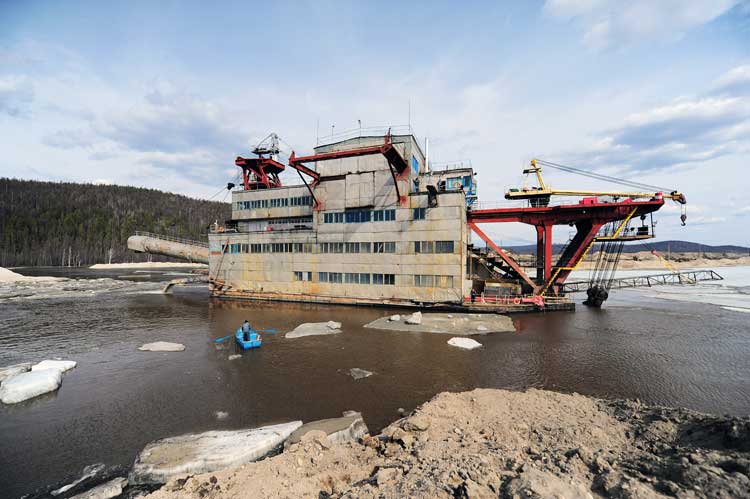
To obtain pure gold, a chemical method is used - the rock is treated with sodium cyanide, which turns even the smallest particles of gold into liquid.
Then, using a special reagent, the metal is given a solid state again. This method allows you to get good results when processing rock in abandoned mines.
Intrigue, however
Maralikha was alarmed. The assumption arose that Savely attacked the gold. The peasants abandoned all their affairs and sent a group to keep the prospector under secret surveillance.
The first week, the second has passed - no news.
In the third week the group arrived in a frenzy. Then they gathered everyone who was interested in Savely’s gold and fishing in Maralikha and reported:
– This morning Savely wandered onto the wild bank of the Kozlukha River. He began to dig holes and wash the rock. We look, the Roman numeral V is picking up the ground upside down. Yes, he digs somehow cheerfully, with fervor, as if he was excited about the discovery. And so it came together. Soon he jumped up, like a bear shakes itself off after water, and started dancing. We took a closer look, and there was a golden sheen in the tray. Then he couldn’t stand it and started humming: “She lived, she lived! She lived, she lived! Goldmine! Oh yes I am!” From the next wash I already scooped up half a tray of golden sand! I went through it again - a full tray! We didn’t look any further, we galloped off with the report.
The interested parties were delighted and began to give advice on what to do. They thought this way and that, but they made a decision - to buy the plot from Savely.
- So what if it’s illegal? Who is aware? There are no government fiscals among us, they convinced themselves.
They sent the group that was conducting the surveillance back (to Savely), but this time to offer to invite them to negotiations.
Gold of the Altai Territory
At the same time, the Altai Territory is one of the significant mining regions of Russia. The first development of copper ore here began more than 2.5 thousand years ago (Chudi period). In 1719–1721, Russian pioneers discovered copper ore deposits here, on the outskirts of the empire, the extraction of which was associated with the famous industrialist A.N. Demidov. In his time, in addition to polymetals, silver and gold began to be smelted from Altai ores. Until the 1870s, Altai supplied Russia with at least 1,000 poods (16 tons) of silver annually, and in total Altai factories produced 116 thousand poods (1856 tons) between 1745 and 1860. They provided 96% of all silver smelting in Russia. From 1745 to 1800, only at the Kolyvano-Voskresensky silver smelting plant, built on the Loktevka River, 124 tons of silver and about 4 tons of gold were produced.
The southwestern part of the region, called Rudny Altai, is rich in non-ferrous metal ores. More than half of this world's largest metallogenic province ended up in independent Kazakhstan after the collapse of the USSR. In the Russian part, deposits of polymetallic ores have been explored in the Loktevsky, Zmeinogorsky and Rubtsovsky regions. In addition to gold, copper, silver, these ores contain lead, zinc, rare and trace elements.
In the early 1980s, placer gold mining in the Altai Territory was resumed by artisanal artisans and gradually grew until 1993. During this period of time, the total production in the region was 40–70 kg. In 1993, the number of operating cooperatives increased to 12, and the volume of gold mining increased to 135 kg per year (1995).
In parallel with the growth of placer gold mining in the region, geological exploration for ore gold was resumed - prospecting work was carried out in the Topolinsky and Murzinsky ore fields and in the Novofirsovsky ore field. The result of these works was the confirmation of forecast estimates made at the stage of regional study of the territory of the region.
However, for more than ten years, gold and polymetallic ores lay untouched in the depths of the region, and only in 2007 was industrial ore mining resumed. A modern production facility (400 thousand tons of ore per year) has been created in the village of Poteryayevka, Rubtsovsky district. This year, a mine is opening at the Zarechenskoye deposit in the Zmeinogorsk region, and in the near future it is planned to develop the largest deposit in the region, Korbolikhinskoye.
Thus, the Altai region is gradually regaining its lost positions in the mining of non-ferrous and precious metals after the revolution. Today, modern production is developing here, based on the maximum use of ore reserves, with high extraction of precious metals and compliance with environmental requirements.
Altai Territory is part of the Siberian Federal District of the Russian Federation (Fig. 1). Territory: 169.1 thousand square meters. km. Population: 2607.4 thousand people. The administrative center is Barnaul (667.6 thousand people).
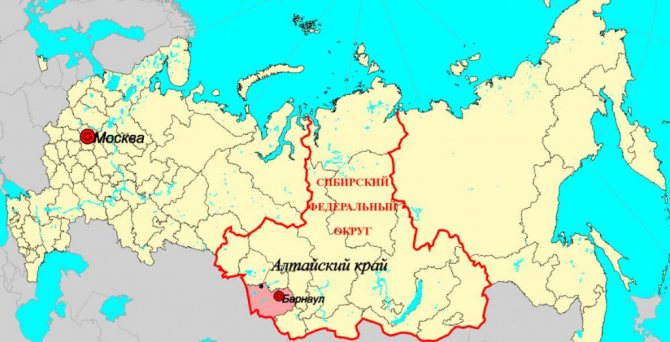
Rice. 1. The situation of the Altai Territory in the Russian Federation.
METALLOGENY OF GOLD EDGE
Almost all mineral deposits, including gold, are concentrated in the southern and eastern parts of the region.
They are localized in the North Altai gold belt
(Fig. 2), which has a total area of about 70 thousand km2 and is located in the southeast of the Altai Territory. Within the belt, several metallogenic zones are distinguished, discussed below.
As part of the Rudno-Altai metallogenic zone
gold-polymetallic
ore districts stand out Gold is part of pyrite-polymetallic ores, significantly enriched in barite, and also forms independent gold ore types of mineralization.

Rice. 2. Map of mineragenic zoning of the Altai Territory.
In the Kayanchino-Ustyubinsk metallogenic zone
with an area of 1250 km2, there is a combination of gold-black shale and gold-skarn mineralization, as well as predicted gold-sulfide disseminated mineralization. In addition, small alluvial gold placers of the river system are known in the zone. Kayancha, non-industrial placer of the river. Ustyub, lithochemical halos and spot flows of gold, which are direct prospecting signs of gold mineralization. In the Kayanchinskaya placer, gold nuggets weighing 7–15 g were noted. Together with gold, platinum, osmic iridium, cinnabar, scheelite, and chromite were noted in the placer.
North Altai-Gorno-Shorsky rare metal-gold ore metallogenic zone
includes Charyshsky, Talitsky and Anuisko-Peschansky ore districts. The prospects for gold in the zone are determined by the presence of numerous ore occurrences of the epithermal gold-silver type and points of copper-polymetallic-silver-gold mineralization. A certain forecast potential of the region for precious metals is primarily associated with the identified ore clusters: Novofirsovsky, Akimovsky, Ust-Belovsky and Chagyrsky, and ore fields localized within their boundaries. In the second - with individual ore fields and objects located outside the ore clusters.
South Altai manganese-iron-gold metallogenic zone
is promising for the development of epithermal gold-silver and copper-gold-porphyry mineralization, along with mesothermal gold-sulfide-quartz mineralization known in the area.
Tigirek-Belokurikha rare metal-gold ore metallogenic zone
covers the northern part of the Permo-Triassic and Jurassic volcano-plutonic province. Mineralization of skarn gold-rare metal, gold-sulfide disseminated and vein gold-sulfide-quartz formations is associated with the ore-generating granitoids of the Aturkol complex.
MINERAL RESOURCE BASE OF GOLD
The Altai Territory has a unique, comprehensive, practically untapped SME sector. In the depths of the region there are reserves of polymetallic ores, gold, nickel, cobalt, aluminum, iron, manganese, titanium, mercury, molybdenum, tungsten, and beryllium. To date, reserves of deposits of placer gold, polymetals, sodium sulfate, underground drinking and medicinal mineral waters, and building materials have been involved in the development. The development of primary gold deposits begins.
Indigenous gold is represented by gold-bearing complex (usually lead-zinc and copper-porphyry), as well as its own deposits and promising occurrences of gold-silver, gold-sulfide and gold-sulfide-quartz ore formation types.
Altai polymetallic
The deposits are characterized by a very compact distribution of balance reserves of industrial ores. Along strike, industrial mineralization can be traced at a distance of 450–1000, rarely up to 2000 m, at a depth of 300–500, rarely at 600–800 m. The ore fields contain up to 15–20 ore bodies, but no more than 3- 5. Thus, at the Korbalikhinskoye deposit, out of 21 ore bodies, the balance reserves of minerals are contained in only 4 ore bodies. Ore bodies are represented by lens-shaped bodies of solid ores, pipe-shaped, vein-shaped and lens-shaped zones of veinlet ores. Their average thickness ranges from 4–5 to 10–15 m.
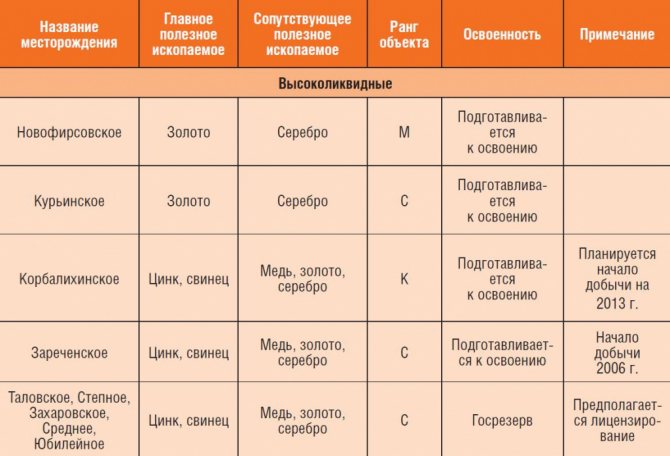
Table
1. Deposits that form the SMEs of gold in the Altai Territory. Note: K – large deposit, S – medium, M – small.
Table 1 characterizes the main deposits that form the MSB of gold in the Altai Territory. Tables 2 and 3 summarize the official reserves and forecast resources of gold and silver in the Altai Territory.
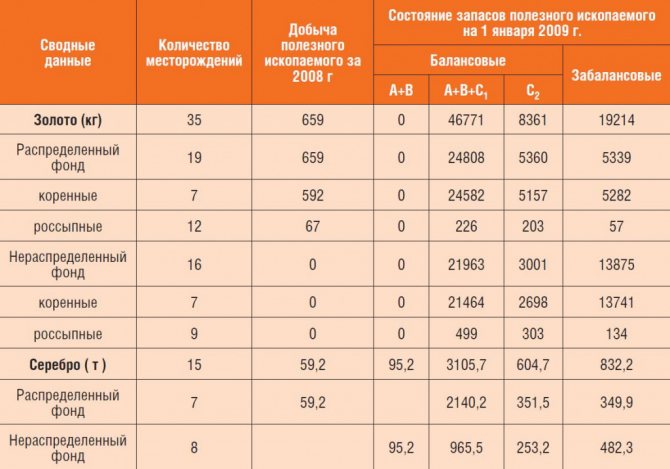
Table 2. Reserves and production of gold and silver in the Altai Territory.
The composition of the ores of complex polymetallic deposits is taken into account by the state balance of reserves of 50.3 tons of gold. In the primary deposits themselves - about 6 tons. Placer gold is accounted for in 25 deposits (1196 kg), of which 232 kg are in the distributed fund. The annual balance increase in reserves of placer gold is about 89 kg, development is carried out by artisanal artisans. In addition, technogenic deposits are known in the region. But their reserves are small. In addition, there are only two licensed sites - in Zmeinogorsk and in the Loktevsky district. According to expert estimates, about 9 tons of gold are concentrated in technogenic deposits of the Altai Territory.

Table 3. Forecast resources of gold and silver in the Altai Territory.
Below is a description of the remaining SMEs of placer gold in the region, using the example of a number of placer deposits put up for auction in 2007-2010. As of January 1, 2010, the total predicted gold resources for categories P1+P2 in the placers of the Pryamaya and Kurchazhnaya rivers amount to 141.5 kg. Placer reserves of the river. Karama (in its lower part, below the village of Stepnoy) is taken into account by the state balance under category C2 in the amount of 103 thousand m3 of sand and 58 kg of gold, with an average content of 563 mg/m3.
In addition to the balance reserves taken into account by the state balance sheet, the Licensed area has off-balance reserves for hydraulic mining in the amount of 1336 thousand m3 of rock mass (134 kg of gold). Placers of the river Bolshoi Mungai in the Zarinsky district of the Altai Territory is located 25 km away. southeast of Zarinsk and 15 km. from the nearest railway station Alambay. The gold content of the Mungai River placer has been known since 1840. This placer was selectively mined until 1910 (120 kg were mined). The placer of the Bolshoi Mungai River belongs to the valley, alluvial type. The length of the exploration part of the placer is about 10 km. The width of the contour varies from 20-90 meters. Gold is medium, flat, 910 ppm. According to available geological information (V.V. Syrovatsky - 1999; N.I. Ovsyannikov - 1993), the placer with similar parameters extends from the mined part to 3–4 km. downstream. The predicted resources of this part of the placer are estimated at 60 kg. The predicted resources of the remaining tributaries of the B. Mungai River are estimated at 200 kg.
Porphyry copper-gold mineralization
has not previously attracted the attention of Altai researchers, although objects of this type can produce deposits with gold reserves from 100 to 1000 tons or more. It should be noted that in many regions of the distribution of porphyry copper and copper-gold-porphyry mineralization (West Pacific metallogenic belt) . Many fields in the Southwestern United States were exploited on a limited scale, and many were mothballed. In the last 50 years, these deposits have been “rediscovered” and have become large objects of the porphyry copper and copper-gold porphyry types.

Table 4. Forecast areas of the Altai Territory. (according to FSUE VSEGEI)
There is a similar picture of the discovery and development of the Ayu-Tologoi copper-gold-porphyry deposit in neighboring Mongolia. This manifestation has been known for a long time as a small copper ore occurrence associated with a porphyry granitoid massif of Permian age, on which geological exploration work was carried out repeatedly, with long interruptions, with the participation of mining exploration companies from Mongolia, Japan, and Canada. As a result of dedicated work on the occurrence, its porphyry nature was established, and it has now turned into a large deposit of copper and gold. The reserves of the latter amounted to 300 tons.
In Altai there are many occurrences of copper and base metals, which were exploited in the 19th century as veins (Soloneshensky, Anuysky mine No. 1, Golovinsko-Charyshsky mine No. 3 and others). A review of the materials on them showed that the richest vein ores were exploited, and the host vein-disseminated ores, which are porphyry copper ore bodies (with lower concentrations of metals), were not delineated and were not exploited. In this regard, the problem arises of including them among objects of a possible copper-gold-porphyry type.
In 2007, prospecting for gold in the weathering crust at Salair was completed. A promising object was also identified here - the Uksunaysky site - with predicted gold resources of 46 tons.
The increase in the gold reserves of the region is expected as a result of prospecting and exploration work in the forecast areas of Kurinsky, Baschelaksky, Charyshsky, Ust-Belovsky and other ore clusters (Table 4), as well as geological exploration work to prepare a reserve for retiring reserves of lead-zinc and polymetallic deposits.
PROMISING GOLD DEPOSITS AND INDICATIONS
Promising for development in the territory of the Altai Territory are the deposits of the Topolevsky and Murzinsky ore fields, the Novofirsovsky and Bashelaksky gold ore clusters
(The section was written based on the analysis and generalization of data published in the press and on the Internet
, as well as the Loktevsky technogenic deposit.
The deposits under consideration are located in infrastructurally developed areas, there is a qualified workforce, the mining and processing technology is quite common and does not require adaptation to the mineral and chemical composition of the ores. Capital investments pay off within a time frame acceptable for mining projects, and subject to further exploration and increase in reserves, the development of gold deposits will bring tangible and stable income. The total annual production of ore gold at these sites can be 1.5-2.0 tons.
Topolinsky ore field. The total area of the gold ore field is 96 km2.
The ore field is connected to the regional center (the village of Soloneshnoye) by roads with dirt and gravel surfaces; in turn, from Soloneshnoye to the city of Biysk there is an asphalt road with a length of 200 km. The nearest railway station, river pier and airport are located in Biysk. There are power lines. The predicted resources of the Topolinsky ore field in category P2 are estimated by analogy with the Sinyukhinsky ore field, where the geological characteristics are similar and the Vesely mine operates, and amount to 50 tons of gold.
Among the most promising are the Bayanikha, Sukhaya Griva (gold-sulfide-skarn type) and Log-26 (gold-sulfide-quartz type) deposits. Available information on the composition of ores allows us to predict the production of 100% gravity concentrate at the Log-26 deposit with minimal costs for its subsequent enrichment and gold extraction. At other deposits, the yield of gold into gravity concentrate, by analogy with the products of the Vesely mine, can range from 30 to 50%. The rest of the gold, with a content of 150-180 g/t, will end up in the copper-sulfide concentrate (26-32% copper). Copper-sulfide concentrate from the Vesely mine is currently being processed in the Urals. An expert estimate of the gold reserves of the ore field deposits is about 30 tons.
The Murzinsky ore field is located in the Kuryinsky district of the Altai Territory, 70 km from the railway station and is connected to it by asphalt (50 km) and dirt roads. The area of the ore field is 42 km2. Within the ore field, three deposits are known that were exploited in the 19th century. For the first time, reserves were approved in 1998 in the amount of 860 kg of gold and 1.7 tons of silver in category C2. In 2007, additional exploration and revaluation of reserves was carried out. Reserves approved in 2007 were: C1 – 1668 thousand tons of ore, 2902 kg of gold, C2 – 1207 thousand tons of ore, 1484 kg of gold. On the state balance sheet in 2008, reserves of category C1 are listed - 1645 thousand tons of ore, 2863 kg of gold, 3006 kg of silver, C2 - 1204 thousand tons of ore, 1480 kg of gold and 1554 kg of silver. Off-balance reserves are 413 thousand tons of ore, 533 kg of gold, 600 kg of silver. Inferred resources are estimated at 25 tons of gold to a depth of 200 m. Annual gold production here can be 400–500 kg. The ores of the deposit are complex and contain 4 g/t gold, up to 26 g/t silver, 0.1-0.24% lead and 0.5-1.59% zinc. Associated mining of these minerals can increase the marketable value of ore by 25–30%.
Novofirsovskoye gold ore field is located 2.5 km from the village. Novofirsovo, which is connected with Art. There is an asphalt road with a length of 40 km. The predicted resources of the ore field were estimated in 1982 at 45 tons of gold, incl. bye. P1 – 5 tons. Explored and preliminary estimated reserves of the deposit amount to 5.2 tons. The ores belong to the epithermal gold-silver formation, complex and contain 5 g/t gold 1.3–42.2 g/t silver, up to 0.41% copper, 0.27–5.75% lead and 0.33–6.58% zinc. Associated mining of these minerals can increase the marketable value of ore by 45-55%. As part of the Novofirsovsky ore cluster, which is promising for the gold-silver type of mineralization, the Novofirsovsky and Kuryinskoye ore fields have been established. The total predicted resources (P1-P2-P3) are estimated at 166 tons of gold. Annual production by heap leaching is planned to be 500–700 kg, starting in 2011.
The Kuryinskoye ore occurrence is the second promising site of the Novofirsovsky ore cluster. It is located 20 km south of the Novofirsovskoye field. There is also a thick zone (more than 100 m) of stockwork epithermal gold-silver mineralization. In some areas, the gold content reaches 12.8 g/t at 15.2 m, the content in the hole. 158 at a depth of 100 m to an apparent thickness of 20 m – 1.42 g/t.
The Baschelaki gold mining cluster is located in the Charyshsky district, 30 km from the regional center of the village. Charysh, which is connected by a dirt road. The gold mining cluster, with an area of 278 km2, includes 4 promising gold ore fields: Central, Potainukhinskoye, Kurtachikhinskoye and Svetlinskoye. The total expert forecast resources for the four indicated ore fields are: gold 87.6 tons, silver 31.6 tons. The deposits of the Baschelaki node are located in the most remote areas of the Altai Territory with undeveloped infrastructure.
The Kurtachikha ore field is controlled by the Sarasino-Inskaya fault zone, which branches in the ore field, forming several sutures. The ore-hosting rocks are represented by granodiorites, adamellites, and aplite-like granites of the Ust-Belovsky complex. All occurrences fit into a single zone of northeastern strike and are represented mainly by quartz veins with disseminated sulfides. Skarns on hornfelsed rocks are less common among the igneous formations of the Ust-Belovsky complex. The thickness of quartz veins varies from 10–20 cm to 1–1.5 m. The predominant sulfide is pyrite, which is found in two generations. The amount of sulfides is 5 to 10%. Native gold gravitates toward lead and zinc sulfides. Sometimes found independently in quartz and without sulfides. The fineness is high – 920–940%. The gold content in the veins ranges from 1 to 15 g/t. Quartz veins are accompanied by beresitization zones up to 3.5 m wide. The gold content in beresites varies from 0.5 to 2 g/t. In addition to the known manifestations of the Kurtachikha ore field, the watershed of the river is of interest. Kurtachikha and R. Borovlyanka, where the “heads” of gold-bearing placers begin. In this watershed, zones of beresitization and quartz veins are also noted.
Potainukhinskoe ore field. Veins of quartz composition with sulfides are localized in the hornblende-biotite granodiorites of the Upper Bashelaksky massif. The Potainukhinsky manifestation is represented by a zone of beresitization up to 4 m thick, traced by ditches and pits for 30 m along strike. It contains veins of quartz with pyrite and arsenopyrite. Sulfide content from 1 to 10%. Gold is contained in quartz and pyrite in the form of irregularly shaped cakes up to 1.5 mm in size. In the zone, the size of ore veinlets with pyrite and galena is up to 5–10 cm. Assay analysis established the gold content - 216.1 g/t, silver - 37.2 g/t. Lead content more than 1%, arsenic up to 0.02%, antimony up to 0.05%. The gold fineness is 900–950%. In addition, the ore field contains numerous occurrences of vein-type gold with metal contents from 1.1 to 25.6 g/t, accompanied by zones of beresitization, similar to the previously described occurrence.
In the ore fields discussed above, it is necessary to carry out prospecting and assessment work to calculate reserves and determine the technology for ore enrichment and gold extraction, and prepare an investment project.
The Sukhonkoye deposit is composed of dolomitized limestones, overlain along a thrust by carbonate-terrigenous deposits of the Lower Devonian, and intruded by rare pre-ore dikes of Devonian dolerites and basalts. The ores are characterized by disseminated, veinlet and stockwork textures. Cinnabar is developed independently, less often in association with calcite, quartz, native gold, realgar, and orpiment. Minor minerals: stibnite, pyrite, marcasite, native sulfur, metacinnabarite, fluorite, barite, arsenate-belovite, mansfieldite. The bulk of arsenic mineralization (realgar, less commonly orpiment) is spatially isolated from the mercury ore bodies. The most saturated with arsenic mineralization, the ore-bearing strata below the subthrust zone of cinnabar mineralization has a vertical thickness of 150–200 m, and in general, its vertical extent exceeds 600 m. Gold-sulfide disseminated mineralization (Carlin type) was established at GDP-200 at the Sukhonkiy Log deposit, where In mercury ores, gold from 0.2 to 34.5 g/t was detected. At the New deposit, the gold content reaches 0.8–2 g/t, and at the Cheremshanskoye deposit – 0.4 g/t. Everywhere in areas of limestone replacement, elongated quartz is a very characteristic feature of the jasperoids of the Western United States. Metasomatic chalcedony-like quartz is often noted, forming rounded segregations with a characteristic radial structure. The jasperoids contain abundant thin cuts of hematite, rare dissemination of marcasite, cinnabar, and metacinnabarite.
Loktevskoye technogenic deposit. The Altai Mining and Processing Plant operated in the Loktevsky district for more than 50 years. It is enough to note that, according to archival data, during the heyday of mining operations from 1747 to 1843, 36 tons of gold and 1200 tons of silver were mined here. As a result of its activities, “tailing dumps” were created from production waste in the amount of 20,738 thousand tons, which contain copper - 26.8 thousand tons, zinc - 81.3 thousand tons, lead - 36.7 thousand tons, gold – 27.0 t.
Based on the analysis of the MSB of gold in the Altai CER, we can recommend the organization of prospecting and exploration work at the following sites.
Forecast objects of the 1st stage:
cost-effective forecast resources for the current planning and development of SMEs of existing enterprises, the creation of new SMEs of highly marketable types of minerals (gold-black shale mineralization of Log No. 26, Baranchinsky, Vodorazdelny ore fields, gold-sulfide mineralization of the Sarasinskaya and Sibiryachikha ore zones and others, epithermal gold-silver mineralization – Novofirsovo ore cluster);
Forecast objects of the 2nd stage:
cost-effective forecast mineral resources for the formation of reserve mineral reserves of gold in the region in the short term (gold-sulfide-quartz mineralization of Baschelaksky, Ust-Belovsky and other ore clusters).
Forecast objects of the 3rd stage:
forecast resources for long-term planning of the development of the mineral resource base (gold-copper-porphyry mineralization of the Charysh ore district and others).
GOLD MINING
In the Altai Territory, placer gold is mined by two artisanal teams, and last year it amounted to only 40 kg. This, according to Altainedra, is an unpromising direction, since there are few placer deposits (see what was written above). The main prospects are related to the development of gold deposits themselves, where it is possible to organize gold production in the amount of 1 - 1.5 tons per year.
Gold mining in the region in recent years has been carried out mainly from alluvial deposits in a volume of about 100 kg, which does not correspond at all to the reserves available on the balance sheet. In the region there are artisanal mines for the extraction of placer gold: Dorozhnaya, Altai-2, Gornyak, Altai Mining and Geological Party LLC, Togul-1, Lazurit LLC and Quartz. But even with more intensive development of existing placer deposits, the possibilities for increasing production are limited to 200 kg per year. Mining of ore gold as an associated component in polymetallic ore is also carried out by Siberia-Polymetals OJSC. In 2007, 157 kg were extracted from ore from the Rubtsovskoye and Zarechenskoye deposits. In 2008, 227 kg were already produced.
In 2010, in the Altai Territory, the volume of gold production amounted to over 1 ton, which is 35.7% more than in 2009 (according to Altainedra). This milestone is a record in Altai in the entire history of gold mining. OJSC "Siberia-Polymetals" received 610 kg of gold during the development of polymetallic ores in the Zmeinogorsk and Rubtsovsky districts, LLC "Poisk" at the Murzinsky gold deposit (Krasnoshchekovsky district) - 320 kg, LLC "Zoloto Kuryi", having commissioned a gold mining factory in December, extracted the first 56 kg of gold from the Novofirsovsky ore field (Kurinsky district).
OJSC Siberia-Polymetals was created on the initiative of the administration of the Altai Territory in 1999 with the aim of reviving the mining of polymetallic ores in the region. In 2004, UMMC acquired the entire complex of unfinished construction objects at the industrial site of the Rubtsovsky mine and began their restoration.
OJSC Sibir-Polymetals, in addition to the Rubtsovskoye and Zarechenskoye polymetal deposits, plans to mine gold at the Stepnoye deposit in the Zmeinogorsk region, the commissioning of which is scheduled for 2011. And together with the launch of the Korbalikhinskoye deposit (Zmeinogorsky district), planned for 2013, Siberia-Polymetals OJSC plans to produce about 0.5 tons of gold annually. Thanks to the commissioning of a gold mining factory in 2010, Zoloto Kuryi LLC plans to produce 550 kg of ore gold this year, which will exceed last year’s result by almost 10 times. Zoloto Kuryi LLC was registered in the Altai Territory in September 2009. In the same year, the LLC bought a license to develop the Novofirsovskoye field from its subsidiary.
LLC “Artel Prospectors “Poisk” (gold mining holding “Seligdar”) plans to extract more than 400 kg of gold from the Murzinsky gold deposit in the Krasnoshchekovsky district this year. The currently explored reserves of the Murzinsky gold deposit amount to about 4 tons. LLC “Artel of Prospectors “Poisk” was registered in the Altai Territory in 2002. The company mines precious metal ores and sands.
The gold reserves contained in the deposits listed in the previous sections make it possible to predict the sustainable operation of the mines for several decades. The existing production of polymetals and gold in the region from existing reserves can be quickly increased several times. However, this will require accelerated prospecting, assessment and exploration work.
CONCLUSION
The general concept of the balanced development of the MSC of the Altai Territory until 2030 and for the future provides for the dynamic development of the economy and social sphere through the effective development of natural resources and long-term sustainable development of the mining industry of the region within the framework of the Altai Central Economic Development District, which is allocated in the southern regions of the Altai Territory and the Republic Altai (Kimelman et al., 2009).
The high prospects for gold in the Altai Territory are determined by the following general geological factors: inclusion in the Altai-Sayan ore belt; the presence of deposits and occurrences of precious metals, significant factors in the discovery of large-volume gold deposits of non-traditional types for the region.
The forecast potential allows us to count on a significant increase in the SMEs of gold in the Altai Territory. To achieve this, it is necessary to increase the volume of prospecting and geological exploration work. New highly liquid deposits may be discovered here. The prospects for the discovery of new ore bodies within the known gold-pyrite-polymetallic ore fields are also high, which is confirmed by the high figures of predicted resources.
In the coming years, it is possible to predict an increase in annual gold production in the Altai Territory to 1.5-1.7 tons. Maximum production volumes of 3-5 tons of gold can be gradually achieved by 2030.
A.V. Volkov – IGEM RAS
Negotiation
Savely didn’t want to go, he didn’t understand why, but then he became interested and gave his consent. He showed up.
During the negotiations, he initially denied everything:
- What are you guys doing? What kind of gold? You yourself dug everything in the area. He is not here.
With these words they pinned him against the wall. They said that they saw everything: the golden sand, and how he dug the vein, in addition to the words, there were three witnesses, six eyes.
With that, the engineer stopped hiding and asked:
- What do you want?
“We want,” answered the interested parties, “to buy the plot from you.”
Savely from Nizhny sat, paused, thought and asked for a large sum.
“I,” he says, “have not really examined the area yet.” Yesterday I washed a pound from two arshins square, and then, you see, nuggets will come, but with such luck, why should I free him?
We agreed with him. They took a three-day delay in order to collect the money and went their separate ways.
Reaction from abroad
Russia's rich resources attract foreign investors. So in June 2021, Prime Minister D. Medvedev signed an agreement with a Chinese company to develop the Klyuchevskoye field in Transbaikalia. The Chinese partners plan to invest $500 million in the enterprise for the extraction of gold and other precious metals, providing 700 jobs directly in production and about 1,500 jobs in related industries. The project also included Indian.
Greed is punishable
On the fourth day Savely arrived, took the money and left. I also wished you one last thing:
- Now the area is yours. Good luck! You can't dig too much!
The Maralikhinskys quickly got ready and galloped as fast as they could to the deserted place they had bought on the Kozlukha River.
For the gold! For the gold!! For the gold!!!
They arrive... And there the Kozlushinskys are sitting on carts, heartbroken, washed with burning tears. Saveliy from Nizhny also gave them a plot with a gold-bearing vein. They gave away the last money. We came and dug. Yes, they dug so much that the piles of rock reach to the sky - only clay and shiny cast iron shavings, painted like gold. If only there was a speck of golden dust lying around somewhere. No way. Empty. They gave away the last money.
It was then that the fraud was revealed.
The Kozlushinskys started shouting:
- He came from you!
And the Maralikhinskys responded:
– It was you who sheltered him and gave him a recommendation.
Everyone got angry and stopped further contact.
Decrease in production
Since 2008, there has been a decrease in the amount of precious metal mined in Siberia. There are several reasons for this:
- Depletion and reduction in the quality of raw materials from developed deposits.
- Lack of qualified personnel.
- Many small enterprises that brought in up to 50 kg of metal annually have closed.
In 2017, the amount of gold mined decreased by 10%. The same decline was observed in 2021, when the Irkutsk region lacked 2.5 tons of gold.
Hard labor will fix
That deception created a lot of noise, even the Governor-General took the investigation under personal control.
The police soon caught the fraudster, but he had already hidden all the money, skipped a walk and drank. Some crumbs showed up on him.
They gave him lifelong hard labor - the judge took pity on him, although he equated the deceiver in terms of the gravity of the act with a counterfeiter, but for the latter he was simply executed then, that’s all. Maybe, the judge thought, he would obey the thief over the years and tell him where he hid the goods? God knows, someone else's soul is in darkness.
Sergey SUVOROV
Real state of affairs
Currently, the main enterprise that produces gold in the Irkutsk region and Krasnoyarsk Territory is Polyuszoloto. It is engaged in the development of ore and placer deposits in the Vitim River basin.
Small enterprises in Siberia have been closing, unable to withstand competition since 2008. In addition, old gold deposits are being depleted, and the search and development of new ones requires the use of modern technologies and large investments.
Prospects for investment in gold deposits in Siberia
Taking into account the launch of a mining and processing plant in the Bodabino district of the Irkutsk region, the region may take first place in the production of valuable metal in 20 years. According to preliminary forecasts, it is planned to obtain 50 tons of gold annually.
In the future, investments are needed in the development of ore deposits, which contain not only precious metals, but also other valuable minerals.
Altai and Kuzbass attract the greatest interest from companies. Every year, regional governments put the sites of possible deposits up for auction.
Legalization of gold mining
For a long time, only legal entities that received a license for this type of activity could engage in gold mining. In 2017, D. Medvedev signed changes to the law “On Subsoil” as part of the liberalization of the situation in the industry.
According to the new legislation, mining can be carried out by an individual. To do this, it is necessary to rent a plot of land on which work is supposed to be carried out. However, there are restrictions:
- Explosives cannot be used.
- You can dive into the ground no more than five meters.
- Use only superficial methods.
Gangs red and white
A version that deserves the reader’s attention was told by the director of the regional centralized library system, Evgenia Dorofeeva. Retreating, the White Guards took away material assets from under the nose of the establishing Soviet power - both what was confiscated from the local population and part of what Admiral Kolchak transported by rail in the “golden echelon”. Evgenia Aleksandrovna draws attention to transport logistics, as if created for such a rescue operation. From the main highway, “Kolchak’s gold,” as we conventionally decided to call the valuable cargo, was sent by Turksib to the Aleyskaya station, then along the Kharitonovo-Ovechkino-Gilevo road and only then reloaded onto a barge to be sent along the Kulunda River to Blagoveshchenka, where the White Guards held out longer than in other villages. Why by water? Because it was the simplest and safest route, which, like the land route, did not require carts, horses and protection from dashing people. On the way to Blagoveshchenka, this barge sank during a severe thunderstorm. And since then, the minds of adventurers have been excited by the sunken treasures of Kolchak.
“When I first read the old pieces of paper, fragile from time to time, on which one of the first Komsomol members of the Sudeiko district, born in 1902, wrote down his memories, everything fell into place for me,” recalls Evgenia. – “Kolchak’s Gold” is not a legend, but a very real story. Otherwise, why did the White Guards need to build a road from Ovechkino to Gilevo, which people still call the old Kolchak road?




